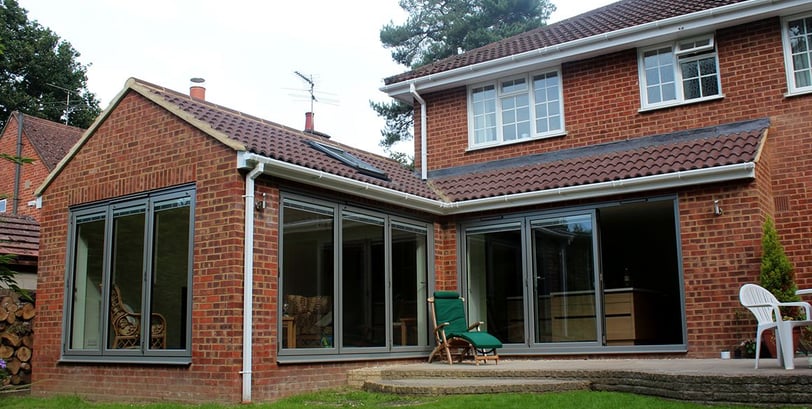Rear-to-Side Extension UK: 2025 Design Ideas, Costs & Planning Tips
5/6/20253 min read


Rear-to-Side Extension Ideas UK: Trending Home Designs for 2025
In 2025, UK homeowners are maximising space and adding significant value to their properties with rear-to-side extensions—a smart blend of two popular extension styles. Whether you live in a Victorian terrace or a detached suburban home, this versatile extension approach can completely transform your ground floor layout.
This guide walks you through everything you need to know: what a rear and side extension is, why it’s trending, planning considerations, and the best design ideas for 2025.
What Is a Rear-to-Side Extension?
A rear-to-side extension (also called a wraparound extension) combines a rear extension with a side return. This L-shaped expansion is especially popular in London and other dense UK cities where homes have long gardens but underused side alleys.
This type of extension can:
Merge small, disconnected rooms into one spacious, open-plan zone
Improve access to natural light
Add usable square footage for kitchens, dining areas, or utility rooms
Drastically boost resale value
Why Rear & Side Extensions Are Trending in 2025
The demand for open, multi-functional ground floors has never been higher. With the rise of hybrid working, family-centric kitchens, and indoor-outdoor living, homeowners are seeking clever ways to modernise older layouts.
Top 2025 extension drivers include:
Work-from-home setups needing more space
Increased desire for entertaining zones connected to gardens
Preference for sustainable, energy-efficient builds
Families looking to extend rather than move due to high mortgage rates
Best Rear-to-Side Extension Ideas for 2025
Here are the most inspiring and practical design ideas for your wraparound extension:
Open-Plan Kitchen with Oversized Island
Transform your cramped galley kitchen into a sociable cooking hub with skylights, underfloor heating, and a garden-facing breakfast bar.
Broken-Plan Living with Crittall Partitions
Use glass and steel partitions to define zones within your open-plan space while maintaining flow and natural light.
Sunken Lounge with Roof Lantern
Create a cosy step-down living area beneath a large glass roof for an atmospheric space full of daylight.
Utility and Pantry Room Hidden in the Side Return
Tuck away laundry or food prep behind discreet doors, freeing up space in your kitchen for living and entertaining.
Biophilic Garden Connection
Install wide aluminium bifold doors or sliding glass panels that open onto a deck or patio, blending indoor and outdoor areas.
Bold Interior Materials
Think polished concrete floors, exposed brick walls, timber cladding, and statement pendant lights—2025 is all about texture and personality.
Planning Considerations in the UK
A rear-to-side extension can often be built under Permitted Development (PD), but there are limitations. Here’s what you need to know:
You may not need full planning permission if:
The rear extension doesn’t exceed 3 m (terraced), 6 m (semi), or 8 m (detached).
The side extension is single-storey, no wider than half the width of the original house.
The combined extension stays within 50% of the garden space.
The height is under 4 m and doesn’t exceed the main house roofline.
You will need full planning permission if:
You’re in a conservation area or listed building.
The side extension faces a highway.
You want a double-storey wraparound.
Your plans significantly alter the front façade.
Pro Tip: Always apply for a Lawful Development Certificate, even for PD projects.
2025 Cost Guide for Rear & Side Extensions
Budget varies by size, design, and location.
Basic rear-to-side extension: from £2,200 to £2,800 per m²
High-spec finishes (custom glazing, bespoke kitchen, smart tech): £3,000–£3,500 per m²
Architect + planning: £2,000–£4,000
Structural calculations: £500–£1,200
Party wall agreement (if semi or terrace): £700–£1,500
Tips for a Successful Rear & Side Extension Project
Hire an experienced architect or design-build team familiar with local council rules.
Prioritise natural light with skylights, roof lanterns, and slim-framed glazing.
Choose materials that match or thoughtfully contrast with your existing home.
Think about the flow between new and old spaces—avoid creating long, dark corridors.
Don’t forget planning for garden landscaping to finish the look.
Does It Add Value?
Yes! A well-designed wraparound extension can increase property value by up to 25%, especially in high-demand urban areas. It adds floor space, enhances functionality, and boosts visual appeal—key factors in the UK property market.
Final Thoughts
A rear-to-side (wraparound) extension is one of the smartest investments for UK homes in 2025. It unlocks hidden space, enhances how your home works for modern life, and adds long-term value. From open-plan kitchens to smart workspaces, the possibilities are endless when designed with care.
